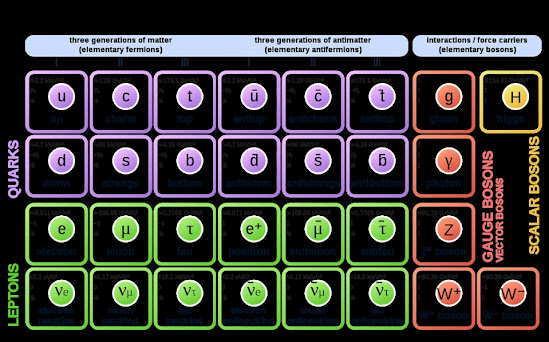Particles comprising the Standard Model.
The muon is familiar to particle physicsts as a heavier, unstable sister of the electron. Muons are created when cosmic rays collide with particles in the Earth’s atmosphere. They are able to pass through matter, and researchers have used them to probe the inaccessible interiors of structures from giant volcanoes to the Egyptian pyramids.
Like electrons, muons have an electric charge and generate minuscule magnetic fields. The strength and orientation of this magnetic field is called the magnetic moment.(expressed in general as: m ℓ z = - g(ℓ) u B m ℓ)
Where, m ℓ = - ℓ, - ℓ +1, 0, ....+ ℓ - and u B is the Bohr Magneton: u B = eh/4p m. Meanwhile, g(ℓ) is known as the "orbital g-factor".
Enter now the Standard Model (see graphic) which contributes to the muon’s magnetic moment in terms of the actions of specific component particles. For decades, physicists have relied on and have been bound by the Standard Model, a suite of equations that enumerates the fundamental particles in the universe (17 by last count) and the ways they interact. It successfully explains the results of high-energy particle experiments in places like CERN’s Large Hadron Collider. But the model leaves deep questions about the universe unanswered, and most physicists believe that a rich trove of new physics waits to be found, if only they could see deeper and farther.
Further, each does so in multiple different ways. Physicists very precisely know how electromagnetism and the weak interaction do so, but determining how the strong interaction contributes to the muon’s magnetic field has proven to be incredibly difficult.
Of all of the effects that the strong interaction has on the muon’s magnetic moment, the largest is also hardest to calculate with the necessary precision. Particle physicists call this largest effect the Leading Order Hadronic Vacuum Polarization.
In the past, to calculate this effect, physicists used a mixed theoretical–experimental approach. They would collect data from collisions between electrons and positrons – the opposite of electrons in charge – and use it to calculate the strong interaction’s contribution to the muon’s magnetic moment. Physicists have been using this approach to further refine the estimate for decades. The latest results are from 2020 and produced a very precise estimate.
This calculation of the magnetic moment is what experimental physicists have been testing for decades. Until April 7, 2021, the most precise experimental result was 15 years old. For this measurement, at Brookhaven National Laboratory, researchers created muons in a particle accelerator and then watched how they moved through a magnetic field using a giant, 50-foot-wide (15-meter) electromagnet. By measuring how muons moved and decayed, they were able to directly measure the muon’s magnetic moment. It came as quite the surprise when Brookhaven’s 2006 direct measurement of the muon’s magnetic moment was larger than it was according to theory.
Faced with this discrepancy, there were three options: Either the theoretical prediction was incorrect, the experiment was incorrect or, as many physicists believed, this was a sign of a hitherto unidentified force of nature.
One new approach produced an estimate of the strength of the muon’s magnetic field that closely matches the experimental value measured by the Brookhaven scientists. It essentially closed the gap between theory and experimental measurements and, if true, confirms the Standard Model that has guided particle physics for decades. Obviously, this would be the most desired outcome since it doesn't upset the theoretical "applecart"
At Fermilab, physicists have been continuing the experiment that was done at Brookhaven to get a more precise experimental measurement of the muon’s magnetic moment. They used a more intense muon source that gave them a more precise result. It matched the old measurement almost perfectly.
The Fermilab results strongly suggest that the experimental measurements are correct. Where we go from here will mark the unfolding story of a unique relationship between experimental and theoretical physics.
What part muons play in the overall pattern of creation is still a puzzle. Columbia University physicist I.I. Rabi once asked:
“Who ordered that?”
When muons were first discovered in 1936. Nowadays, muons are produced copiously at places like the Large Hadron Collider when more ordinary particles are crashed together at high energies.
More astounding discoveries and findings are certain to come. Stay tuned!

No comments:
Post a Comment